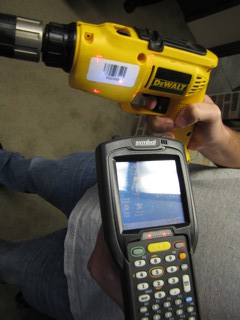
|
Industrial Work-in-Process Tracking Software |

|

While primarily used for inventory tracking, LPMTS is also an excellent Asset Tracking system, especially where asset tracking is needed at multiple geographically separated locations. BellHawk enables assets to be tracked anywhere there is an Internet connection available, whether this is within the four walls of facilities or at field sites.
Some of the assets that BellHawk is suitable for tracking include equipment, tools, computers, jigs, fixtures, furniture, molds, carts, and vehicles. BellHawk can track the location of these assets or who they are issued to. It can also track when these assets need maintenance, recalibrating, or have reached end-of-life.
BellHawk uses "license-plate" tracking technology where every asset is given a unique tracking barcode and/or RFID tag. These asset tracking tags can be as simple as a pre-printed roll of tracking barcodes from which tracking barcodes can be peeled off and attached to each asset and then scanned to record the asset into inventory.
When the assets are moved to a location then the asset tag barcode is scanned and its new location recorded, usually by scanning a "location"barcode for the building, room, cabinet or other location to which the asset is moved. Alternately assets can be issued to people by scanning the asset tag and a barcode on the badge of the person to whom the asset is issued.
If human readable information is required on the asset tag then these can be printed out on demand on a barcode printer when the asset is first recorded into inventory. If a combination barcode printer and RFID tag encoder is used then asset tracking tags can be printed out that have embedded RFID chips and antennas. These RFID tags can then be read whenever the asset goes through an RFID portal to automatically record its movement, such as in and out of buildings.
If vehicles, carts, totes or other assets that are subject to harsh environments are to be tracked then permanent metal barcodes and/or ruggedized RFID tags are attached to these assets.
One of the challenges facing any organization is periodically taking an inventory of their assets. The BellHawk Inventory Auditing Module enables users to scan the location barcode for a room, cabinet or other such location and then scan the tracking barcodes on all the assets that are present. At the completion of taking inventory at that location, the system compares what is physically there with what should be there and stores this in a discrepancy table.
The person taking inventory is then able to enter an explanation for any discrepancies. This discrepancy data is then made available to the asset manager, with an audit trail to record the subsequent actions taken.
One major feature of BellHawk for inventory auditing is that assets can still be received and issued and tracked while auditing is taking place. Only the location being audited is "locked" while the inventory at that location is taken. This makes it possible to audit inventory on a periodic basis with different sections of one or more facilities being audited on different days.
BellHawk also has a quick-check mode whereby a location barcode can be scanned and a list of the contents that should be there at that time can be seen on a mobile device. If the user is authorized they can make any needed adjustments at that time.
A very useful feature of inventory auditing is automated move-matchup. Assets frequently are moved from the location to which they were issued to another location. BellHawk will automatically match up missing assets from one location with excess assets in another location and automatically move them in the database, with an appropriate note in the audit report.
Asset tracking often requires more than the capture of the make, model and location of each asset. It can also require the capture of additional parameters such as the condition, color or size, or more detailed information such as the operating system and version installed. Certain parameters are standard, such as the initial value of the asset and the date on which the unit needs maintaining or inspecting but most are provided using the User Defined Parameter option in BellHawk.
This option allows the user to specify a set of parameters to be collected for each class of asset when the asset is first entered into inventory and then updated throughout the life of the asset. These parameters can be specified to only allow certain choices or numerical values such that data entry can be verified and, unlike free-form text fields, the resultant data used for sorting data in custom reports.
One use for the user defined parameters is to specify asset depreciation parameters such as depreciation method, number of years, and rate of deprecation. These can then be used by the MilramX interface to periodically update the asset values in an accounting system.
BellHawk can be configured as a powerful stand-alone asset tracking system or used as a combined asset and inventory tracking system. This latter feature enables assets, such as computers or furniture, to be received against purchase orders as regular inventory and then to be issued as assets to people or places. BellHawk also enables the recording of the shipment or delivery of these assets to customer sites as well as recording their return for repair and refurbishment.
Please click here to learn more about "How BellHawk Uses License-Plate Tracking Methods to Track Inventory"